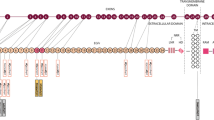Abstract
Background and purpose
Cerebral autosomal dominant arteriopathy with subcortical infarcts and leukoencephalopathy (CADASIL) is a hereditary disorder caused by NOTCH3 mutations and characterized by recurrent subcortical infarctions, dementia and leukoencephalopathy. So far, most clinical, molecular and neuroimaging information has come from Caucasians. Therefore, we investigated the spectrum of NOTCH3 mutations and MRI features in CADASIL patients of Chinese origin on Taiwan.
Methods
Mutational analysis of NOTCH3 exons 2 to 23 by direct nucleotide sequencing was performed in patients with clinically suspected CADASIL. MRI findings were retrospectively evaluated and scored using a modified Schelten’s scale.
Results
Nine different point mutations of NOTCH3 were identified in 21 unrelated patients. Intriguingly, 47.6 % were in exon 11, and 19 % in each of exon 4 and 18. R544C was very common and present in all patients with a mutation in exon 11. Many patients with NOTCH3 R544C share the same haplotype linked to the mutation using markers D19S929 and D19S411, which flank the NOTCH3. The sensitivity of T2-weighted MRI detecting anterior temporal abnormality was only 42.9 %. Furthermore, the neuroimaging evidence of intracerebral hemorrhage (ICH) was present in 23.8 % of the 21 patients.
Conclusions
A population-specific mutational spectrum of CADASIL was found in the Chinese patients on Taiwan. The Chinese patients carrying NOTCH3 R544C may descend from a common ancestor. Anterior temporal hyperintensity on T2-weighted MRI may not be a sensitive marker for CADASIL. ICH is a relatively common manifestation of CADASIL in East Asians, especially in the presence of hypertension.
Similar content being viewed by others
References
Tournier-Lasserve E, Joutel A, Melki J, et al. (1993) Cerebral autosomal dominant arteriopathy with subcortical infarcts and leukoencephalopathy maps on chromosome 19q12. Nat Genet 3:256–259
Chabriat H, Vahedi K, Iba-Zizen MT, et al. (1995) Clinical spectrum of CADASIL: a study of 7 families. Lancet 346:934–939
Ruchoux MM, Guerouaou D, Vandenhaute B, et al. (1995) Systemic vascular smooth muscle cell impairment in cerebral autosomal dominant arteriopathy with subcortical infarcts and leukoencephalopathy. Acta Neuropathol 89:500–512
Joutel A, Corpechot C, Ducros A, et al. (1996) NOTCH3 mutations in CADASIL, a hereditary adult-onset condition causing stroke and dementia. Nature 383:707–710
Artavanis-Tsakonas S, Matsuno K, Fortini ME (1995) Notch signaling. Science 268:225–232
Joutel A, Vahedi K, Corpechot C, et al. (1997) Strong clustering and stereotyped nature of NOTCH3 mutations in CADASIL patients. Lancet 350:1511–1515
Markus HS, Martin RJ, Simpson MA, et al. (2002) Diagnostic strategies in CADASIL. Neurology 59:1134–1138
Peter N, Opherk C, Bergmann T, et al. (2005) Spectrum of mutations in biopsy-proven CADASIL. Implications for diagnostic strategies. Arch Neurol 62:1091–1094
Joutel A, Dodick DD, Parisi JE, et al. (2000) De novo mutation in the Notch3 gene causing CADASIL. Ann Neurol 47:388–391
O’Sullivan M, Jaroz JM, Martin RJ, et al. (2001) MRI hyperintensities of the temporal lobe and external capsule in patients with CADASIL. Neurology 56:628–634
Choi JC, Kang SY, Kang JH, et al. (2006) Intracerebral hemorrhage in CADASIL. Neurology 67:2042–2044
Wang ZX, Lu H, Zhang Y, et al. (2004) NOTCH3 gene mutations in four Chinese families with cerebral autosomal dominant arteriopathy with subcortical infarcts and leukoencephalopathy. Zhonghua Yi Xue Za Zhi 84:1175–1180
Lee YC, Yang AH, Liu HC, et al. (2006) Cerebral autosomal dominant arteriopathy with subcortical infarcts and leukoencephalopathy: Two novel mutations in the NOTCH3 gene in Chinese. J Neurol Sci 246:111–115
Mykkanen K, Savontaus ML, Juvonen V, et al. (2004) Detection of the founder effect in Finnish CADASIL families. Eur J Hum Genet 12:813–819
Scheltens P, Barkhof F, Leys D, et al. (1993) A semiquantitative rating scale for the assessment of signal hyperintensities on magnetic resonance imaging. J Neurol Sci 114:7–12
Malandrini A, Gaudiano C, Gambelli S, et al. (2007) Diagnostic value of ultrastructural skin biopsy studies in CADASIL. Neurology 68:1430–1432
Lesnik Oberstein SAJ (2003) Re: Diagnostic Strategies in CADASIL. Neurology 60:2019–2020
Dotti MT, Federico A, Mazzei R, et al. (2005) The spectrum of NOTCH3 mutations in 28 Italian CADASIL families. J Neurol Neurosurg Psychiatry 76:736–738
Joutel A, Monet M, Domenga V, et al. (2004) Pathogenic mutations associated with cerebral autosomal dominant arteriopathy with subcortical infarcts and leukoencephalopathy differently affect Jagged 1 binding and NOTCH3 activity via the RBP/JK signal pathway. Am J Hum Genet 74:338–347
Pescini F, Sarti C, Pantoni L, et al. (2006) Cerebellar arteriovenous malformation and vertebral artery aneurysm in a CADASIL patient. Acta Neurol Scand 113:62–63
Engelter ST, Rueegg S, Kirsch EC, et al. (2002) CADASIL Mimicking primary angiitis of the central nervous system. Arch Neurol 59:1480–1483
Viswanathan A, Guichard JP, Gschwendtner A, et al. (2006) Blood pressure and haemoglobin A1c are associated with microhaemorrhage in CADASIL: a two-centre cohort study. Brain 129:2375–2383
Desmond DW, Moroney JT, Lynch T, et al. (1999) The natural history of CADASIL: a pooled analysis of previous published cases. Stroke 30:1230–1233
Author information
Authors and Affiliations
Corresponding author
Rights and permissions
About this article
Cite this article
Lee, YC., Liu, CS., Chang, MH. et al. Population-specific spectrum of NOTCH3 mutations, MRI features and founder effect of CADASIL in Chinese. J Neurol 256, 249–255 (2009). https://doi.org/10.1007/s00415-009-0091-3
Received:
Revised:
Accepted:
Published:
Issue Date:
DOI: https://doi.org/10.1007/s00415-009-0091-3




